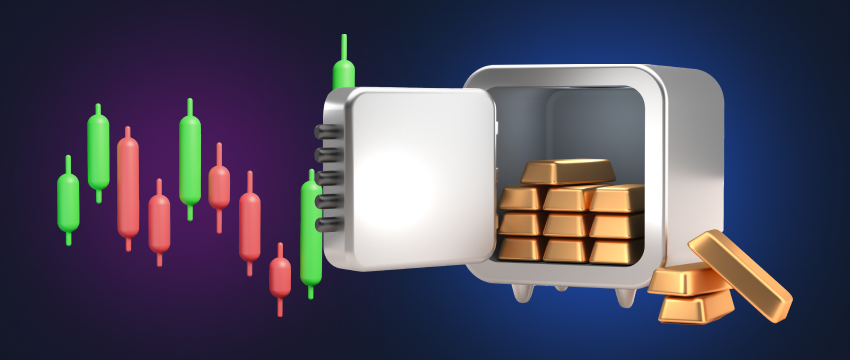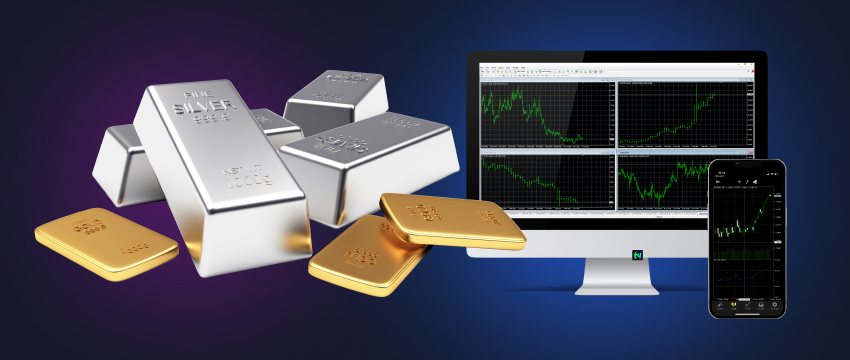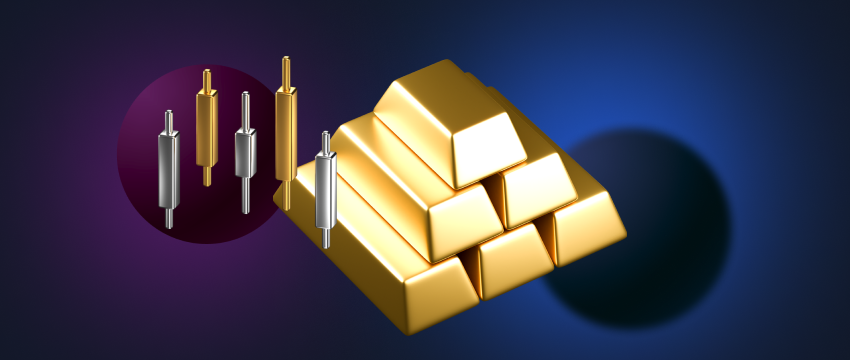Precious metals are highly valuable metals (commodities) that are rare. They are typically traded as a portfolio diversifier and a hedge against currency inflation or financial uncertainty. Three of the most popular precious metals are gold, silver, and platinum. Each one comes with its own distinct risks and opportunities.
Precious metals are also considered volatile investments for several reasons including scarcity, price fluctuations, economic or geopolitical instability, supply and demand, etc.
If you’re a beginner as far as precious metals trading is concerned, read on for some useful insights on the different types of precious metals, how they work, ways of investing in them, and the risks involved.
Gold
Gold remains a highly coveted commodity across global markets. While it has many uses, gold is largely sought after as a form of currency and as a popular jewellery choice due to its malleability.
The price at which gold is purchased
The price of gold is determined daily and adjusted in real-time. Two pricing models are generally applied:
- Gold futures: a standardised contract to buy or sell an amount of gold on a future date. The contract represents a fixed sum of gold. The rate is based on the current value of gold (the spot gold rate).
- Spot gold: the transaction for trading gold occurs on the spot, i.e., it’s the price at that gold can be bought and sold immediately, not a date in the future.

What influences the price of gold?
There are several factors that impact gold prices worldwide including:
- Value of the US dollar: gold is a dollar-denominated commodity which makes for an inverse relationship between the price of gold and the strength of the dollar, i.e., the stronger the US dollar, the lower the gold prices.
- Lãi suất: when interest rates increase, gold prices may weaken as traders may be more inclined to sell gold as a means of raising capital for other trading opportunities.
- Gold production: the production of gold worldwide influences the price of this precious metal. Today, access to quality gold reserves has become more challenging. Miners must dig deeper, there are elevated risks of exposure to hazards, and environmental impact devastating in certain parts of the world. If, as a result, the cost of gold mine production increases, then gold prices may rise as well.
- Consumer goods: if the demand for goods like jewellery and electronics rises, so too does the price of gold.
- Wealth protection: gold is often considered a safe haven asset during economic volatility. Its enduring value appeals to investors, as does its ability to be used as a hedge against currency devaluation or inflation. It is also widely considered a means of protection during war or political instability.
- Central bank reserves: central banks in countries worldwide look to diversify their portfolios. One measure is the move away from paper currencies and into gold. This usually results in the price of gold rising.
- Supply vs demand: the price of gold may go up when gold consumption increases. Alternatively, when the demand for gold decreases, so too does its price.

Gold trading online
There are several ways a gold trader can trade gold. This includes:
- buying the precious metal in its physical form (e.g., gold coins, gold bullion, gold jewellery)
- purchasing stock in gold mining companies
- through mutual funds or ETFs (exchange-traded funds) that hold precious metals, or
- buying options on gold futures or options on a gold ETF
There are many reasons why gold trader or investor chooses the method they do to invest or trade in gold. It may be to use leverage to profit from rising gold prices. Leverage-based holdings do however come with significant risk. It could be to hedge against inflation in which case an investor may be more inclined to invest in gold coins, bullion, or jewellery. For someone looking to avoid holding onto this physical precious metal, investing in shares in a gold mining company may be their answer.
Like any other investment, investing in or trading gold comes with advantages and disadvantages. Research and analysis are key to mitigating large losses, where possible.
Silver
Price fluctuations for silver are typically more volatile than for gold. Its price is impacted by its uses (its applications) and new innovations. Silver is typically purchased by investors or silver traders through commodities markets.
Trading silver
There are many ways to trade silver. Silver traders’ will usually select their preferred method based on skills, experience, knowledge, budget, and goals. Trading methods include:
Contracts for Difference (CFDs)
A CFD is a financial derivative through which a trader speculates on the price of silver rising or falling, without having ownership of the silver. The CFD is entered into between a trader and a broker. The aim is to profit from the price difference between when the position opens and closes. CFDs offer several benefits:
- Smaller capital is required for capital.
- They offer leverage.
- Through CFDs, you also have the possibility of speculating on silver prices without owning the precious metal.
Silver futures
Silver futures offer a way for silver traders to speculate on the price of silver without owning the precious metal. Future contracts may appeal to investors because of the high leverage they offer, meaning less capital is required to open a significantly large position in silver. If silver futures move in the right direction, traders stand to make a very high return very quickly. However, you may make a big loss just as fast if the market moves against you.
Purchasing silver in its physical form
Another way to invest in silver is through physical silver coins or bullion. Like gold, silver is regarded as a safe haven investment. It may also offer significant protection against inflation. However, when investing or trading in silver, be mindful of the spot price (ensure it’s fair). Further, like any physical asset, silver can be stolen, so take measures to properly safeguard or even insure it.
Exchange-traded funds (ETFs)
Silver traders not wanting to own physical silver directly, and prefer a relatively lower-risk method than futures; may go the route of an exchange-traded fund (ETF). The iShares Silver Trust (SLV) and the Aberdeen Standard Physical Silver Shares ETF (SIVR) have made it less challenging for retail investors to enter the silver market. However, there are many risks associated so be mindful when trading.

Platinum
Platinum is traded on commodities markets worldwide. Its rarity sometimes sees this precious metal fetching a higher price per ounce than gold. Platinum is considered to be both a precious metal as well as an industrial metal because of its widespread use in the automotive industry. It is also used in jewellery manufacturing. The petroleum and computer industries also make use of platinum.
Platinum prices are typically impacted by supply and demand and also by the geopolitical climate of the region in which it is mined. Almost 90% of the world’s platinum is mined in South Africa. Other platinum-mining countries include Russia, Zimbabwe, the US, and Canada. Platinum is generally regarded as one of the most volatile precious metals as far as platinum trading is concerned.
The drawbacks of trading precious metals
Investing in precious metals comes with obvious advantages. However, there are also some drawbacks (and risks) involved in trading precious metals.
For instance, gold doesn’t produce any passive income whereas stocks do (e.g., through dividend payouts). Instead, while gold increases in value over time, an investor cannot make money off it unless the asset is sold. Further, if one owns the physical metal, then there are other costs to consider, e.g., shipping, storage, insurance, and transaction fees.
Precious metals are also highly volatile, impacted by a range of factors that we’ve already touched on in this article. While this opens avenues for making huge profits, if left unchecked, can also lead to large losses.
Mitigating risks associated with the online metal trading
Set a goal and then build a strategy to help you achieve it. Analyse and understand the complexities unique to each market. Choose a precious metals trading method that best suits your skill set. Monitor world markets and track price fluctuations. Finally, remember that all trading involves risk. It is possible to lose all your capital. So, consider whether you can afford to take the high risk of losing your money.
Khước từ trách nhiệm: This material is for general informational & educational purposes only and should not be considered as investment advice or an investment recommendation. T4Trade is not responsible for any data provided by third parties referenced or hyperlinked, in this communication.



